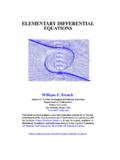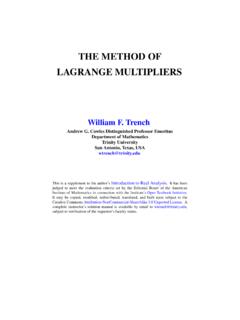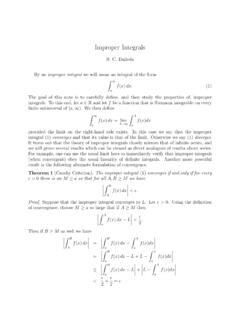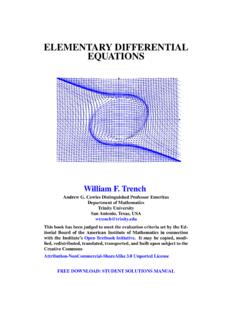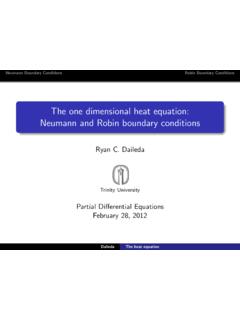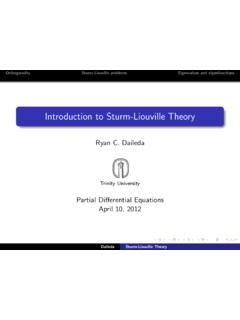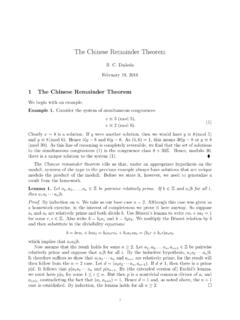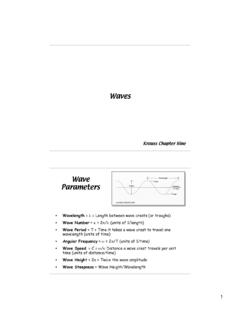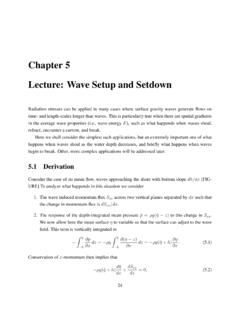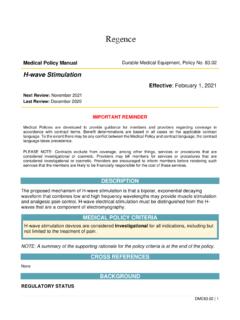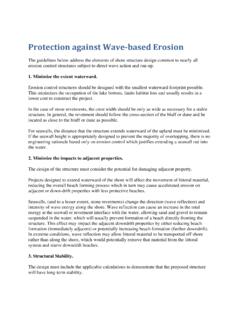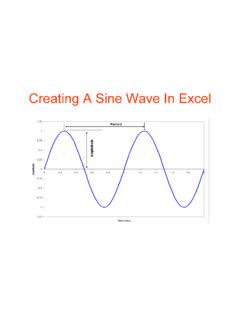Transcription of The two dimensional wave equation - Trinity University
1 The 2D wave equationSeparation of variablesSuperpositionExamplesThe two dimensional wave equationRyan C. DailedaTrinity UniversityPartial Differential EquationsMarch 1, 2012 DailedaThe 2D wave equationThe 2D wave equationSeparation of variablesSuperpositionExamplesPhysical motivationConsider a thin elastic membrane stretched tightly over arectangular frame. Suppose the dimensions of the frame area band that we keep the edges of the membrane fixed to the the membrane from equilibrium results in somesort of vibration of the goal is to mathematically model the vibrations of themembrane 2D wave equationThe 2D wave equationSeparation of variablesSuperpositionExamplesWe letu(x,y,t) =deflection of membrane from equilibrium atposition (x,y) and a fixedt, the surfacez=u(x,y,t) gives the shape of themembrane at ideal assumptions ( uniform membrane density, uniformtension, no resistance to motion, small deflection, etc.) one canshow thatusatisfies thetwo dimensional wave equationutt=c2 2u=c2(uxx+uyy)(1)for 0<x<a, 0<y< 2D wave equationThe 2D wave equationSeparation of variablesSuperpositionExamplesRemarks:Fo r the derivation of the wave equation from Newton s secondlaw, see exercise in the one dimensional situation, the constantchas theunits of velocity.
2 It is given byc2= ,where is the tension per unit length, and is mass operator 2= 2 x2+ 2 y2is called theLaplacian. It will appear in many of oursubsequent 2D wave equationThe 2D wave equationSeparation of variablesSuperpositionExamplesThe fact that we are keeping the edges of the membrane fixed isexpressed by theboundary conditionsu(0,y,t) =u(a,y,t) = 0,0 y b,t 0,u(x,0,t) =u(x,b,t) = 0,0 x a,t 0.(2)We must also specify how the membrane is initially deformed andset into motion. This is done via theinitial conditionsu(x,y,0) =f(x,y),(x,y) R,ut(x,y,0) =g(x,y),(x,y) R,(3)whereR= [0,a] [0,b].DailedaThe 2D wave equationThe 2D wave equationSeparation of variablesSuperpositionExamplesSolving the 2D wave equationGoal:Write down a solution to the wave equation (1) subject tothe boundary conditions (2) and initial conditions (3).We will follow the (hopefully!) familiar process ofusingseparation of variablesto produce simple solutions to(1) and (2),and then theprinciple of superpositionto build up asolution that satisfies (3) as 2D wave equationThe 2D wave equationSeparation of variablesSuperpositionExamplesSeparation of variablesWe seek nontrivial solutions of the formu(x,y,t) =X(x)Y(y)T(t).
3 Plugging this into the wave equation (1) we getXYT =c2(X YT+XY T).If we divide both sides byc2 XYTthis becomesT c2T=X X+Y the two sides are functions of different independentvariables, they must be constant:T c2T=A=X X+Y 2D wave equationThe 2D wave equationSeparation of variablesSuperpositionExamplesThe first equality becomesT c2AT= second can be rewritten asX X= Y Y+ again, the two sides involve unrelated variables, so both areconstant:X X=B= Y Y+ we letC=A Bthese equations can be rewritten asX BX= 0,Y CY= 2D wave equationThe 2D wave equationSeparation of variablesSuperpositionExamplesThe first boundary condition is0 =u(0,y,t) =X(0)Y(y)T(t), 0 y b,t we want nontrivial solutions only, we can cancelYandT,yieldingX(0) = we perform similar computations with the other threeboundary conditions we also getX(a) = 0,Y(0) =Y(b) = are no boundary conditions 2D wave equationThe 2D wave equationSeparation of variablesSuperpositionExamplesFortunatel y, we have already solved the two boundary valueproblems forXandY.
4 The nontrivial solutions areXm(x) = sin mx, m=m a,m= 1,2,3, ..Yn(y) = sin ny, n=n b,n= 1,2,3, ..with separation constantsB= 2mandC= 2D wave equationThe 2D wave equationSeparation of variablesSuperpositionExamplesRecall thatTmust satisfyT c2AT= 0withA=B+C= ( 2m+ 2n)<0. It follows that for any choiceofmandnthe general solution forTisTmn(t) =Bmncos mnt+B mnsin mnt,where mn=c 2m+ 2n=c m2a2+ are thecharacteristic frequenciesof the 2D wave equationThe 2D wave equationSeparation of variablesSuperpositionExamplesAssembling our results, we find that for anypair m,n 1 we havethenormal modeumn(x,y,t) =Xm(x)Yn(y)Tmn(t)= sin mxsin ny(Bmncos mnt+B mnsin mnt)where m=m a, n=n b, mn=c 2m+ 2D wave equationThe 2D wave equationSeparation of variablesSuperpositionExamplesRemarks:No te that the normal modes:oscillate spatially with frequency min thex-direction,oscillate spatially with frequency nin they-direction,oscillate in time with frequency mand nare simply multiples of /aand /b,respectively, mnis not a multiple of any basic 2D wave equationThe 2D wave equationSeparation of variablesSuperpositionExamplesSuperposit ionAccording to the principle of superposition, because the normalmodesumnsatisfy the homogeneous conditions (1) and (2), wemay add them to obtain the general solutionu(x,y,t) = n=1 m=1sin mxsin ny(Bmncos mnt+B mnsin mnt).
5 We must use a double series since the indicesmandnvaryindependently throughout the setN={1,2,3, ..}.DailedaThe 2D wave equationThe 2D wave equationSeparation of variablesSuperpositionExamplesInitial conditionsFinally, we must determine the values of the coefficientsBmnandB mnthat are required so that our solution also satisfies the initialconditions (3). The first of these isf(x,y) =u(x,y,0) = n=1 m=1 Bmnsinm axsinn byand the second isg(x,y) =ut(x,y,0) = n=1 m=1 mnB mnsinm axsinn are examples ofdouble Fourier 2D wave equationThe 2D wave equationSeparation of variablesSuperpositionExamplesOrthogonal ity (again!)To compute the coefficients in a double Fourier series we canappeal to the following functionsZmn(x,y) =sinm axsinn by , m,n Nare pairwise orthogonal relative to the inner producthf,gi= a0 b0f(x,y)g(x,y)dy is easily verified using the orthogonality of the functionssin(n x/a) on the interval [0,a].DailedaThe 2D wave equationThe 2D wave equationSeparation of variablesSuperpositionExamplesUsing the usual argument, it follows thatassumingwe can writef(x,y) = n=1 m=1 Bmnsinm axsinn by,thenBmn=hf,ZmnihZmn,Zmni= a0 b0f(x,y) sinm axsinn by dy dx a0 b0sin2m axsin2n by dy dx=4ab a0 b0f(x,y) sinm axsinn by dy dx(4)DailedaThe 2D wave equationThe 2D wave equationSeparation of variablesSuperpositionExamplesRepresenta bilityThe question of whether or not a given function is equal to adouble Fourier series is partially answered by the following f(x,y)is a C2function on the rectangle[0,a] [0,b], thenf(x,y) = n=1 m=1 Bmnsinm axsinn by,where Bmnis given by(4).
6 To say thatf(x,y) is aC2functionmeans thatfas well asits first and second order partial derivatives are all not as general as the Fourier representation theorem,this result is sufficient for our 2D wave equationThe 2D wave equationSeparation of variablesSuperpositionExamplesConclusion TheoremSuppose that f(x,y)and g(x,y)are C2functions on the rectangle[0,a] [0,b]. The solution to the wave equation (1)withboundary conditions(2)and initial conditions(3)is given byu(x,y,t) = n=1 m=1sin mxsin ny(Bmncos mnt+B mnsin mnt)where m=m a, n=n b, mn=c 2m+ 2n,DailedaThe 2D wave equationThe 2D wave equationSeparation of variablesSuperpositionExamplesTheorem (continued)and the coefficients Bmnand B mnare given byBmn=4ab a0 b0f(x,y) sinm axsinn by dy dxandB mn=4ab mn a0 b0g(x,y) sinm axsinn by dy have not actually verified that this solution isunique, this is theonlysolution to the wave equation with thegiven boundary and initial can be proven using an argument involvingconservation of energyin the vibrating 2D wave equationThe 2D wave equationSeparation of variablesSuperpositionExamplesExample 1 ExampleA2 3rectangular membrane has c= 6.
7 If we deform it to haveshape given byf(x,y) =xy(2 x)(3 y),keep its edges fixed, and release it at t= 0, find an expression thatgives the shape of the membrane for t> 2D wave equationThe 2D wave equationSeparation of variablesSuperpositionExamplesWe must compute the coefficientsBmnandB mn. Sinceg(x,y) = 0 we immediately haveB mn= also haveBmn=42 3 20 30xy(2 x)(3 y) sinm 2xsinn 3y dy dx=23 20x(2 x) sinm 2x dx 30y(3 y) sinn 3y dy=23(16(1 + ( 1)m+1) 3m3) (54(1 + ( 1)n+1) 3n3)=576 6(1 + ( 1)m+1)(1 + ( 1)n+1) 2D wave equationThe 2D wave equationSeparation of variablesSuperpositionExamplesThe coefficients mnare given by mn= 6 m24+n29= 9m2+ all of these pieces yieldsu(x,y,t) =576 6 n=1 m=1((1 + ( 1)m+1)(1 + ( 1)n+1)m3n3sinm 2x sinn 3ycos 9m2+ 4n2t).DailedaThe 2D wave equationThe 2D wave equationSeparation of variablesSuperpositionExamplesExample 2 ExampleSuppose in the previous example we also impose an initial velocitygiven byg(x,y) = sin 2 an expression that gives the shape of the membrane for t> only on the initial shape, which hasn tchanged, we don t need to recompute only need to findB mnand add the appropriate terms tothe previous 2D wave equationThe 2D wave equationSeparation of variablesSuperpositionExamplesUsing the values of mncomputed above, we haveB mn=23 9m2+ 4n2 20 30sin 2 xsinm 2xsinn 3y dy dx=23 9m2+ 4n2 20sin2 xsinm 2x dx 30sinn 3y first integral is zero unlessm= 4, in which case it evaluatesto 1.
8 Evaluating the second integral, we haveB 4n=13 36 +n23(1 + ( 1)n+1)n =1 + ( 1)n+1 2n 36 +n2andB mn= 0 form6= 2D wave equationThe 2D wave equationSeparation of variablesSuperpositionExamplesLetu1(x,y, t) denote the solution obtained in the previousexample. If we letu2(x,y,t) = m=1 n=1B mnsinm 2xsinn 3ysin mnt=sin 2 x 2 n=11 + ( 1)n+1n 36 +n2sinn 3ysin 2 36 +n2tthen the solution to the present problem isu(x,y,t) =u1(x,y,t) +u2(x,y,t).DailedaThe 2D wave equatio
